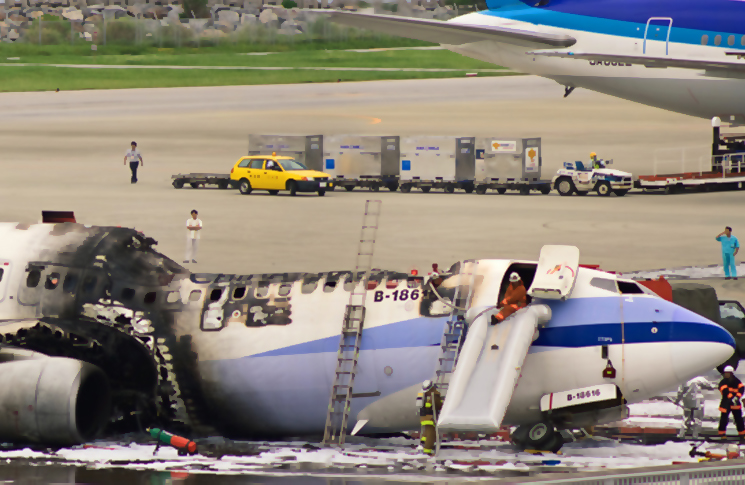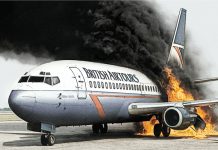There is a tangible sense of relief when a large passenger aircraft touches down. The sound of the landing gear reacquainting itself with the earth is indeed a cheery sound—especially when it’s accompanied by the sound of decreasing wind rush to a more gentlemanly (and survivable) speed. In fact on touchdown—especially after turbulent flights—it’s almost traditional for passengers to break into enthusiastic (and relieved) applause. The ground movement phase of a big jet seems to be the equivalent of pulling into the driveway at home—it’s all pretty much over and everyone can relax. Everybody can breathe a sigh of relief.
But can they?
Flight 120, a Boeing 737 just landed at Naha Airport mid-morning on 20 August 2007 had given six years and 13,000 hours worth of reasons why crew and passengers could ‘relax’ as the aircraft taxied to parking. In all that time there were no incidents worth mentioning during flight and certainly none during ground operations. All that was about to change.
Unknown to the crew and passengers, an incorrectly installed bolt in the right wing of the aircraft’s No 5 slat down-stop had worked itself loose. During maintenance action some six weeks before, the bolt—requiring a mirror, seemingly double-jointed dexterity and extreme patience to tighten—had been torqued without the requisite washer in place. This meant a false reading on the torque wrench, and over some weeks the nut on the retention bolt worked itself loose. This, in turn, caused the entire down-stop assembly to detach and fall onto the track of the slat-can assembly sometime during Flight 120’s inbound ground movement to parking.
While the passengers waited for the seat-belt sign to switch off and the crew ran the post-landing checklist to retract the slats, the detached down-stop assembly moved dangerously along the slat track jamming itself against the metal skin of the track housing. On the other side of the housing’s metal skin was jet fuel. The hydraulic pressure powering the track actuator and the foreign protrusion of the down-stop assembly easily punctured the aluminium and volatile jet fuel began leaking freely into the jet efflux of the right-hand engine. Thankfully, at least during the taxi, the forward movement of the aircraft and the rearward airflow of the engines turbo-fan pushed the fuel stream harmlessly clear of the red-hot exhaust.
As the aircraft rolled to a stop in parking bay 41, a waiting maintenance engineer noticed the fuel stream. He would later describe it as ‘leaking in torrents, like a heavy rain, from the wing-root portion on the outboard side of the No. 2 engine’. Meanwhile in the aircraft, passengers prepared themselves to exit the aircraft. Seatbelts were undone, baggage compartments opened and passengers dutifully lined up in the aisle. In the cockpit, the two pilots completed the engine shutdown checklist and two turbo-fan engines were shut down.
‘Leaking in torrents, like heavy rain …’
As for touchdown, engine shutdown in the parking bay is a time to relax. The plane is stopped, the engines are stopped, everybody can rest … but in this case the very situation which usually prompted such pleasant feelings of ‘safeness’ was the very state which now placed the passengers and crew in mortal danger. The cessation of rearward airflow with the shutdown meant fuel began cascading directly onto hot exhaust parts. The observant maintenance engineer approached the suspect engine to confirm what it was that was ‘leaking in torrents, like heavy rain’ and caught some of the leakage in his hand.
‘It’s fuel!,’ he shouted to the assistant engineer and almost at the same time the fuel streaming onto the engine ignited. The No 2 engine exhaust was cooling after shutdown, but was still at about 400 degrees. Most jet fuel has a spontaneous ignition point of about 240–250 degrees. Heat (400 degrees worth), oxygen (fanned by a brisk ten knot breeze) and fuel (gallons of volatile liquid jet fuel) formed the perfect fire triangle and the flames leapt hungrily up the wing and towards the fuselage. The maintenance engineer yelled at his assistant to alert the crew via the interphone of the spreading flames, and then he rushed to the front of the aircraft himself and gestured wildly at the aircraft pilots alerting them to the danger.
Inside the cabin, the chief flight attendant was monitoring the passengers. Most of them had retrieved their carry-on and were standing in the aisle waiting to disembark. From the cockpit he suddenly heard the raised voice of the captain and ground crew talking animatedly.
“Fire! Fire!” and “Repeat, Repeat” from the cockpit then, over the PA system, “Attention! Crew On Station! Attention! Crew On Station!”
Looking out the window the flight attendant could see a small amount of black smoke spiraling upwards, and assumed it was a ground fire unrelated to the aircraft and that the safest thing to do would be to stay on the aircraft. He instructed the cabin crew to re-arm the doors, but at the same time the captain’s voice over-rode his with ‘Passengers Evacuate… Passengers Evacuate!’
With the passengers already out of their seats and the doors disarmed the evacuation was completed relatively quickly. This was life saving. As the last of the crew and passengers fled across the tarmac, the main fuel cells of the aircraft ignited causing a violent explosion. The last of the fleeing crew, a pilot, was knocked to the ground from the cockpit window, as the plane was physically jolted upwards and broken in half. Despite the close call, there were no serious injuries or deaths recorded.
Chronic unease
The term ‘chronic unease’ often gets bandied about in safety discussions. Like a lot of safety terms it rolls off the tongue easily, with a sophisticated, ‘I’m using a cool-sounding phrase’ feel to it. But if we really believe the laws of safety are brothers to the laws of physics then such terms should have impact not just at safety conferences but more importantly within earshot of the high-pitched whine of jet engines; that is, in the real world.
So how does it apply in the real world and to an accident such as flight 120? The safety sage, James Reason, described the concept of chronic unease as an active ‘wariness towards risks’. Elsewhere it’s described as ‘a healthy scepticism about one’s own decisions and the risks that are inherent in work environments.’ In essence it’s a new expression of the old (but good) safety truism: ‘Hope for the best, plan for the worst’.
Flight 120 though gives us an interesting reality check when it comes to chronic unease: it shows there is a ‘yang to its yin’. This is something we could call ‘chronic ease’. If chronic unease is defined as a ‘healthy scepticism’ about risk, then chronic ease must surely be the congenial acceptance of risk. It is a ‘hope for the best, plan for the best’ attitude. Chronic ease (‘chronic’ literally ‘lasting a long time’ and ‘ease’ meaning ‘without effort’) is the feeling that comes from walking safely near a cliff 999 times and assuming the thousandth time will be the same. Or, as in the case of flight 120, the feeling that comes from 13,000 hours worth of flight and ground operations and the assumption the next hour will be no different—safe, relaxed and uneventful.
Everything is awesome … or is it?
The difference between ease and unease exists as a difference in assumption. A complacent acceptance assumes everything goes on as it always has and there’s no reason to think the next thing will be any different. Of course it’s no surprise the ‘ease’ assumption demands very little safety effort or rigour. In fact if chronic ease had a theme song it would be The Lego Movie’s ‘Everything is Awesome’. On the other hand (probably the hand with a protective glove), a healthy wariness assumes the worst can happen and then reasonably plans and prepares for it. As a famous practitioner of chronic unease, Mark Twain, once said ‘its better to be prepared a thousand times than dead once’.
But here’s the problem. Twain never told us how to stay prepared through the 999 iterations of complacency-inducing mundaneness so that we might be prepared for the thousandth time of danger. Flight 120 though offers three good incentives towards chronic unease and perhaps some suggested ‘hows’ for the long road of the mundane.
The first incentive to be prepped for the worst is the knowledge any modern aircraft is a complex gathering of metal, plastic, rubber and electrics held together by a multitude of bolts and rivets each of which must be inspected at regular intervals. Even small-scale and routine maintenance checks on small aircraft can involve some 22 pages with 15 items to check per page. This means 330 separate components must be inspected, any one of which, if faulty and missed, could produce a flight 120-like event. Engineers can practise chronic unease by checking and re-checking their work even when duplicates aren’t required. Pilots can ‘have the back’ of their engineers by double-checking panels and visible components with the uneasy assumption even the best engineers have bad days—or fatigued days, or stressed days, or distracted days. Operators can plan for the worst by reading and re-reading airworthiness directives (AD) and then reading and re-reading the plethora of literature on their own aircraft types. In the case of flight 120 an uncannily similar incident on another 737 was well documented. The track can was punctured and a fuel leak developed, but the wording of the subsequent AD was open to interpretation and only some of the down-stop assembly bolts were checked fleet-wide.
A second incentive is the awareness jet fuel is a fire looking for a place to happen (pretty much the definition of a ‘flammable’ liquid); and if it does happen, it will happen quickly. The only thing standing between said fire is the thin-skinned aluminium integrity of the fuel containment system. The only thing that will put out an aircraft fire once it starts is the rapid application of heavy-duty fire-retardant—literally truck-loads of it.
The accident transcript of the radio dialogue between fire engines and ground control once the fire started on flight 120 is more grist for the chronic unease mill. It shows numerous delays, questions of clarification, confusion and eventually a late arrival at the exploding aircraft some four minutes after initiation—a response time twice that of the recommended ICAO time. When they finally did arrive the wind was on their side (literally) keeping the flames away from the nearby terminal. Against protocol, the airport fire authorities did not request assistance from the city fire assets. Practitioners of chronic unease would have requested this assistance very early on, especially because accident investigators later assessed that, if not for the wind, the airport fire authorities would not have been able to prevent the fire engulfing the terminal.
The final incentive of flight 120 towards an attitude of chronic unease is the fact that such a catastrophic accident was primed after landing and then triggered after engine shutdown—both times passengers and crew normally and subconsciously take that aviation sigh of relief. In Australia, the Australian Transport Safety Bureau reported some 300 ground operation occurrences over a 10-year period from 1998 to 2008. While none was as spectacular as flight 120 in Japan, nearly 30 per cent involved quite serious aircraft-to-vehicle or aircraft-to-obstacle collisions. This is a collective reminder the ‘wariness’ factor needs to stay high whenever an aircraft is involved in ground operations.
Chronic unease requires effort. Chronic unease requires constant reminders both in human factors training and in the various daily or weekly operations/crew/admin briefings. And when that 999th briefing, or checklist procedure, or safety drill number seems wearisome or mundane consider that if the final evacuation for flight 120 had been even a few minutes slower, many of the crew and passengers would have been consumed. It was hundreds of weary drills and boring checks which, even when carried out with some ‘glitches’, meant all the passengers and crew escaped unscathed. Perhaps, gathering in the evacuation areas and thinking about their near death experience they could really breath a deep, deep aviation sigh of relief …
But could they?
What would a chronic unease practitioner say? Everything is not always awesome, stay wary … there will be many more bolts to tighten, routes to fly and aircraft to park.
Suggested reading
‘Human Error’, James Reason, Cambridge University Press, 20th edn, 2009.






Comments are closed.